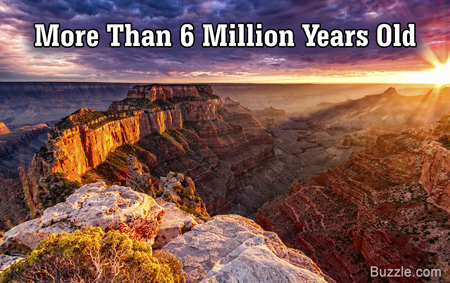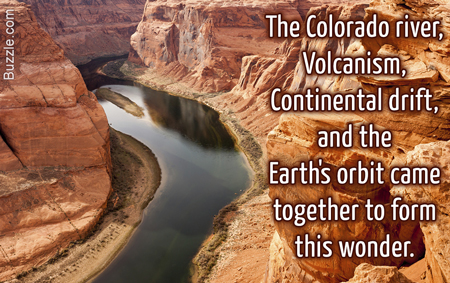
When was the Grand Canyon Formed?

The exact date as to when the Grand Canyon was formed is still controversial. With reference to geological data, the Colorado River was believed to have originated somewhere around 60 - 70 million years ago and its basin about 40 million years ago. Early scientific studies claimed the origin of the canyon to be about 6 million years ago. While a more recent geological study, published in 2008, revealed that this steep-sided canyon originated as early as 17 million years ago.
How was the Grand Canyon Formed?

The exact reasons for creation of this astounding canyon are not known. Of course, there are many assumptions and theories. The erosive activity of the Colorado River is thought to be the prime cause for formation of the Grand Canyon. Certain other forces, like change in the Colorado river course, volcanism, continental drift, and the Earth's orbit contributed to the creation of this landform. For your understanding, a brief explanation concerning how the Grand Canyon was created is discussed below.
Prior to its formation, the area was believed to be occupied by a chain of mountain ranges. These mountains, after a span of millions of years, had become plain due to erosion activities of water, ice, and wind. Meanwhile, due to the sudden climatic changes, the oceans moved over these areas and deposited rock layers. This process was repeated many a time, resulting in the deposition of several rock layers. At times, the interval between two consecutive depositions was so vast that the upper layer usually got eroded completely by natural forces before the second layer was deposited.
At this point of time, the ancestral Colorado River came into existence (about 70 million years ago). In those times, the course of the river was subject to changes, mainly due to alteration in the surrounding terrain. The tributaries of the Colorado River also contributed to the erosion process. Then, about 16 -17 million years ago, the Colorado Plateau was uplifted due to pressure from underneath the Earth's crust and movement of the tectonic plates.
The rise in the elevation from the sea level prevented the submersion of these areas by the seas. On the other hand, the Colorado River continued to erode the canyon sides. Apart from the erosive activity of the Colorado River, the debris flow (fast flowing mass of rocks and boulders resulted from flash flood) played a major role in the widening and deepening of the Grand Canyon.
All these factors contributed to the formation of the Grand Canyon, which remains an intriguing feature for everyone of us and especially for the geologists. The rock layers, as we have seen, are actually formed due to depositions by the oceans and seas. This is evident from the fact that rocks found on the sides of the canyon are mostly of sedimentary type. Also, fossils collected from the site are mainly of marine organisms, such as sea lilies, mollusks, corals, fish, etc.
Speaking more about the rock layers in the walls of the canyon, they reveal the geological history of about two billion years. One such example is the Vishnu Schist found at the bottom of the canyon. Studies indicate that there is a gap of about 1 billion years between the layers of 1.5 billion years old and 500 million years old. This major gap is believed to be a period of erosion. The rock samples from the Grand canyon are collected for studying the geological processes that took place at that time.
Prior to its formation, the area was believed to be occupied by a chain of mountain ranges. These mountains, after a span of millions of years, had become plain due to erosion activities of water, ice, and wind. Meanwhile, due to the sudden climatic changes, the oceans moved over these areas and deposited rock layers. This process was repeated many a time, resulting in the deposition of several rock layers. At times, the interval between two consecutive depositions was so vast that the upper layer usually got eroded completely by natural forces before the second layer was deposited.
At this point of time, the ancestral Colorado River came into existence (about 70 million years ago). In those times, the course of the river was subject to changes, mainly due to alteration in the surrounding terrain. The tributaries of the Colorado River also contributed to the erosion process. Then, about 16 -17 million years ago, the Colorado Plateau was uplifted due to pressure from underneath the Earth's crust and movement of the tectonic plates.
The rise in the elevation from the sea level prevented the submersion of these areas by the seas. On the other hand, the Colorado River continued to erode the canyon sides. Apart from the erosive activity of the Colorado River, the debris flow (fast flowing mass of rocks and boulders resulted from flash flood) played a major role in the widening and deepening of the Grand Canyon.
All these factors contributed to the formation of the Grand Canyon, which remains an intriguing feature for everyone of us and especially for the geologists. The rock layers, as we have seen, are actually formed due to depositions by the oceans and seas. This is evident from the fact that rocks found on the sides of the canyon are mostly of sedimentary type. Also, fossils collected from the site are mainly of marine organisms, such as sea lilies, mollusks, corals, fish, etc.
Speaking more about the rock layers in the walls of the canyon, they reveal the geological history of about two billion years. One such example is the Vishnu Schist found at the bottom of the canyon. Studies indicate that there is a gap of about 1 billion years between the layers of 1.5 billion years old and 500 million years old. This major gap is believed to be a period of erosion. The rock samples from the Grand canyon are collected for studying the geological processes that took place at that time.
Hiç yorum yok:
Yorum Gönder
Yapacağınız yorumlar bizim için değerlidir. (Lütfen yorum bırakın)